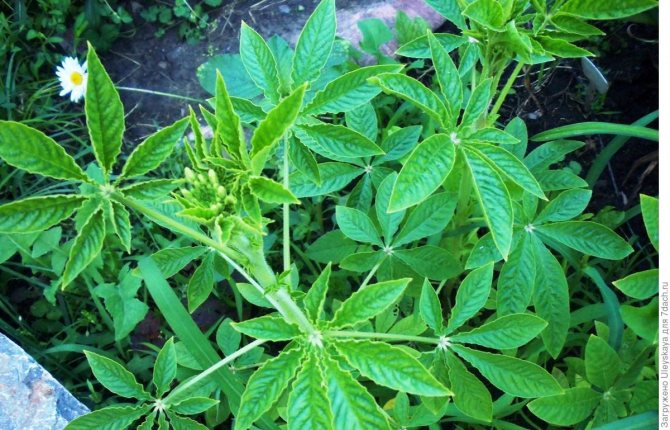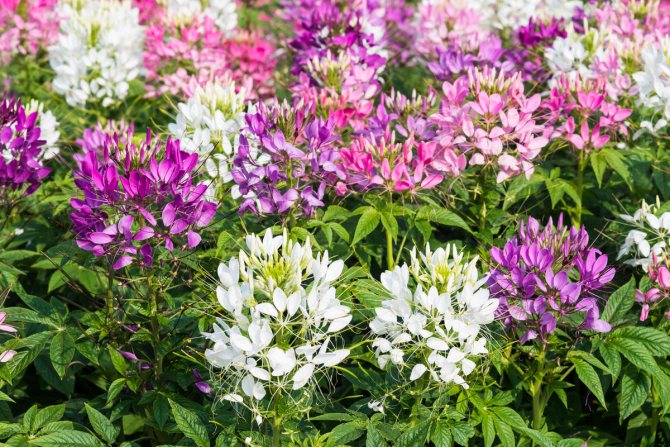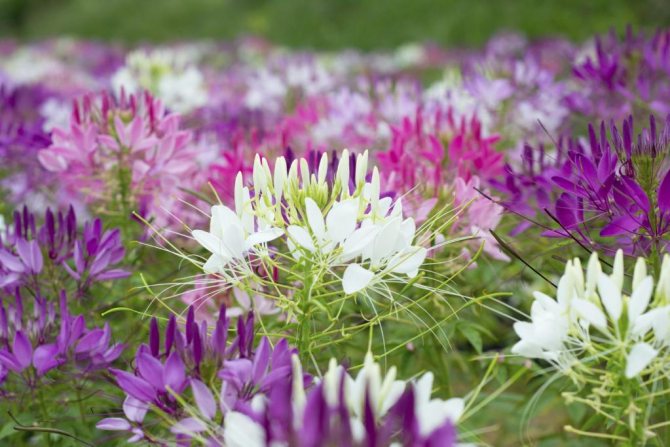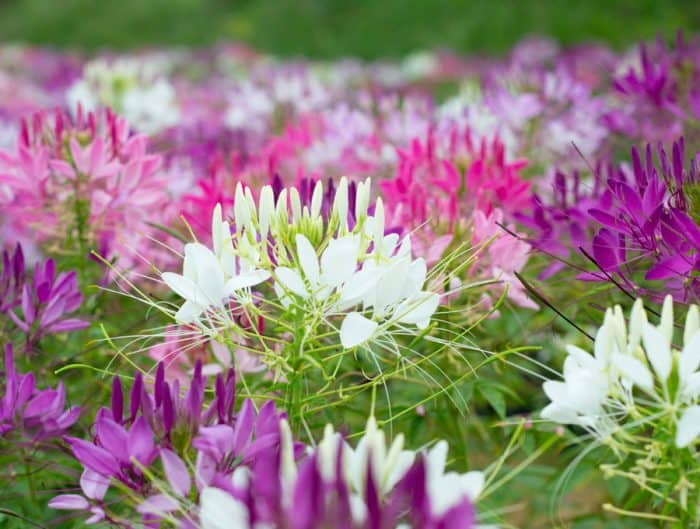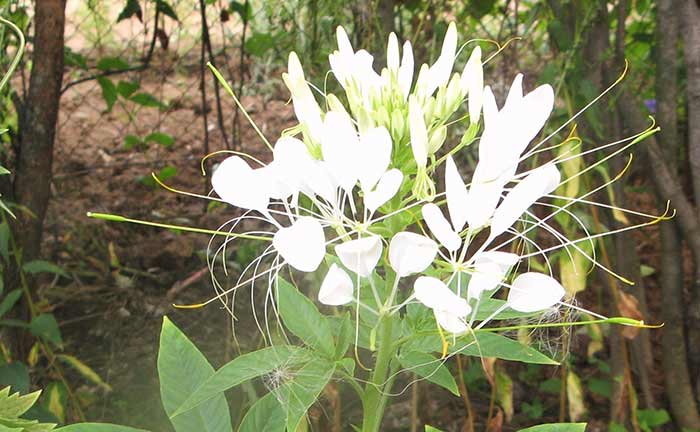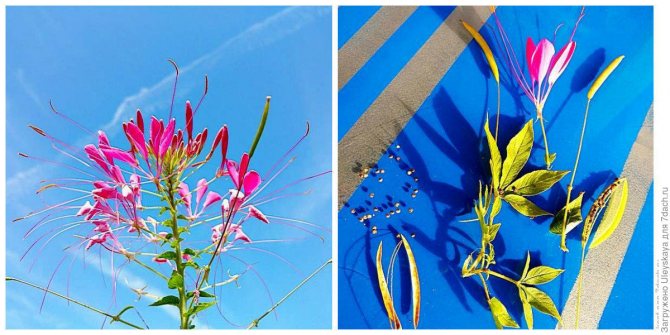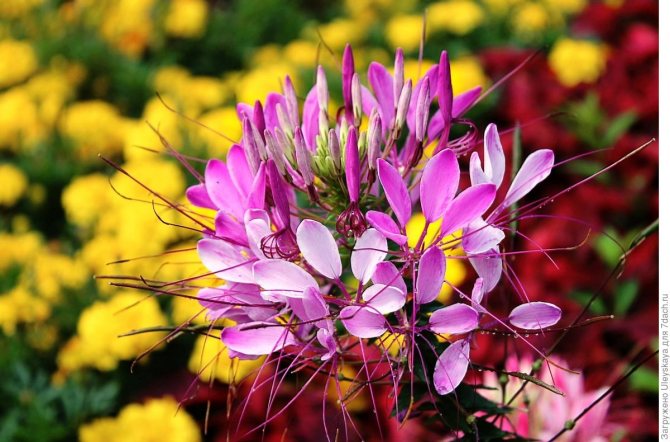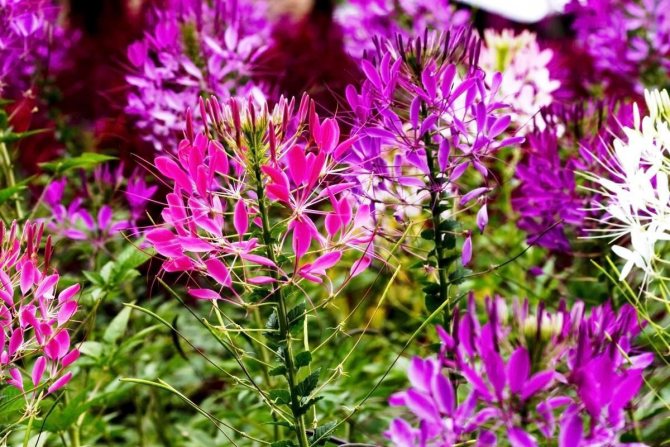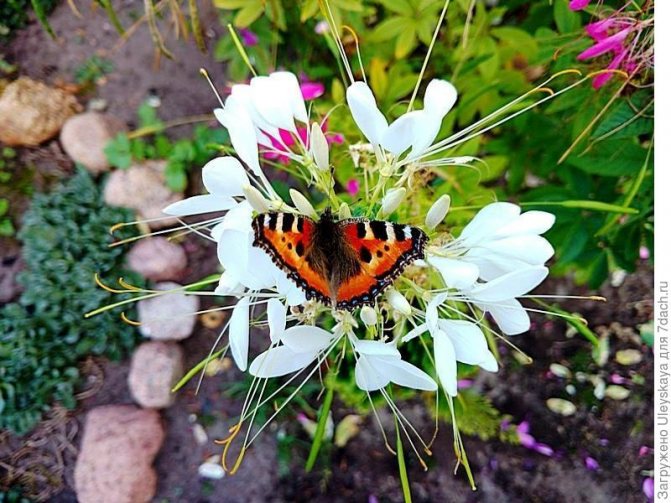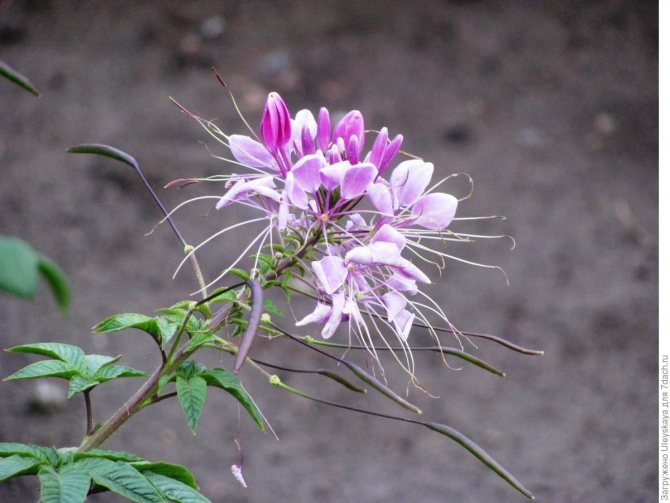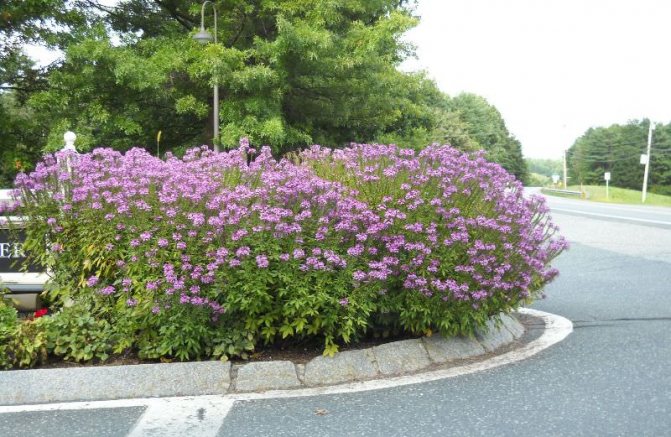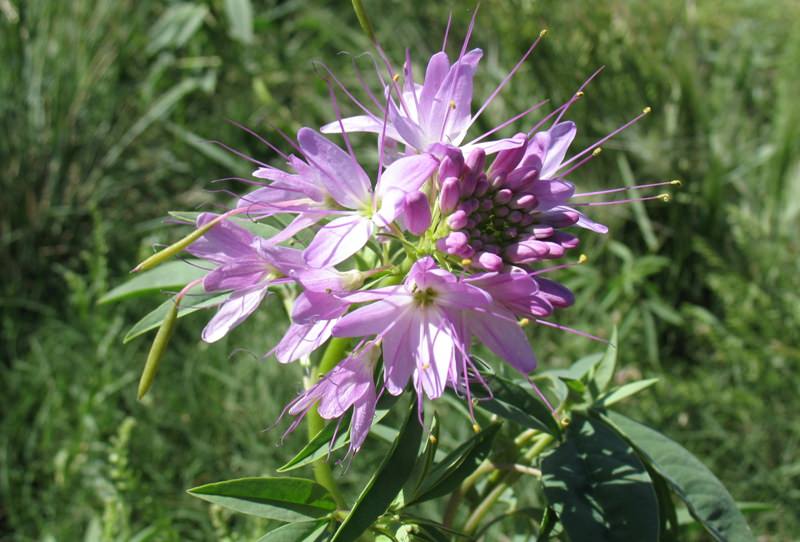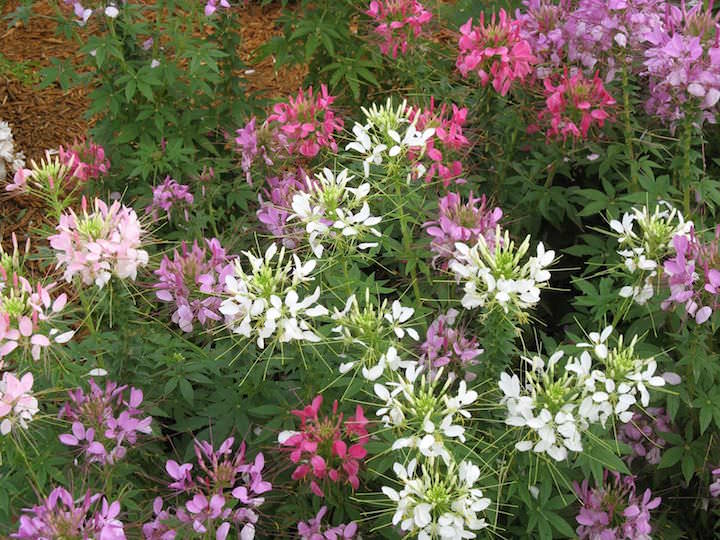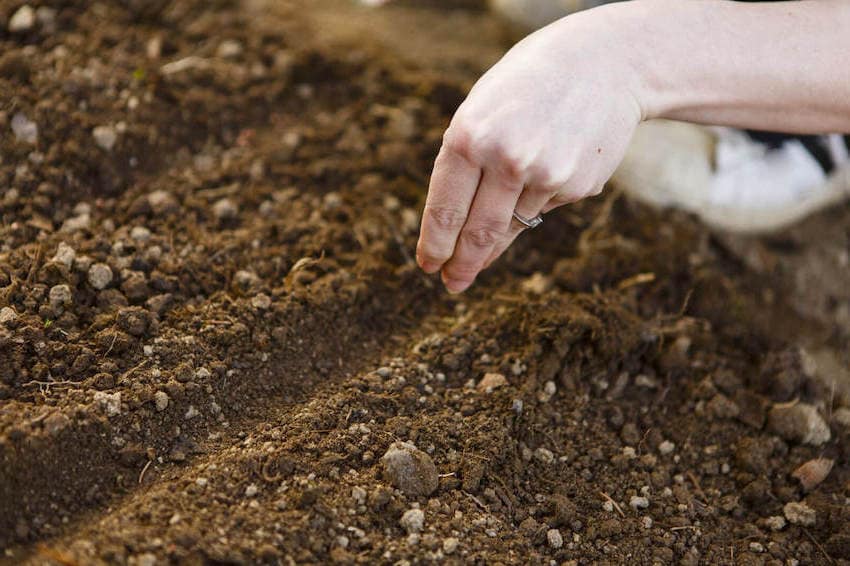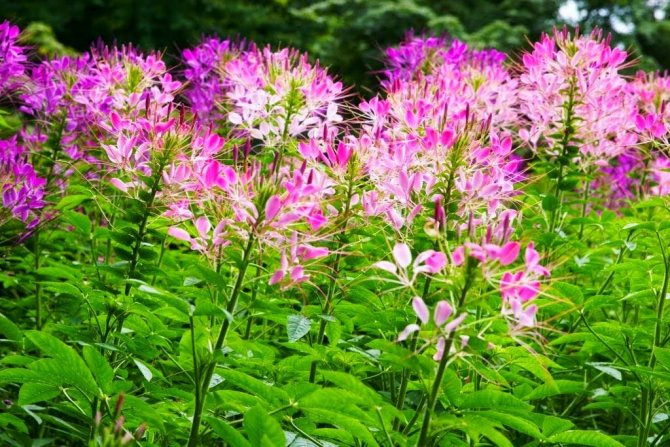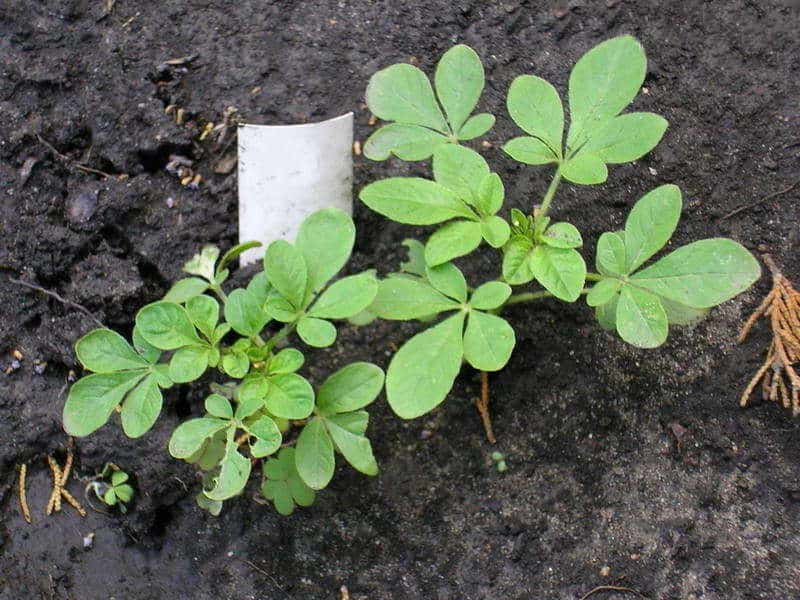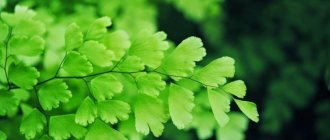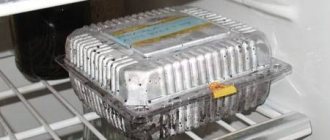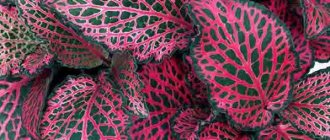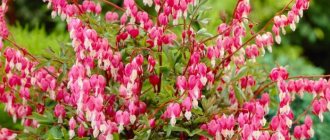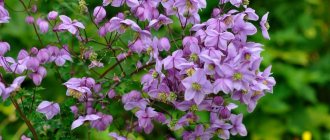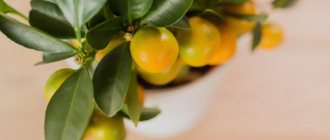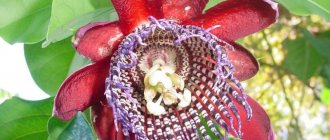Among the annual stars, few of the plants can compete in size with cleoma. This is a unique shrub, surprising not only with its beauty, but also with its stickiness. But nevertheless, the main attention of cleoma is attracted by “thorny” inflorescences with amazing airy flowers. This not the easiest annual to grow is suitable for anyone looking for exotic solutions among seasonal garden decorations. Cleoma is one of the most original non-resistant plants.
Cleome prickly (Cleome Spinosa). <>
How to grow glue?
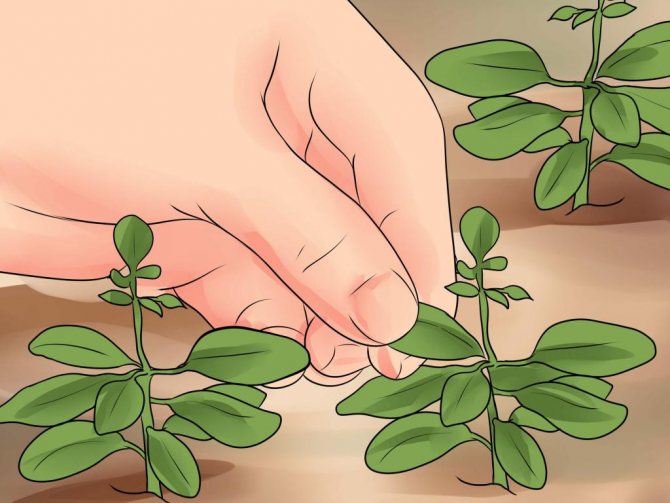
Although the plant is a guest from the tropical climate, in our region it grows beautifully as an annual flower in the open field. In one season, the cleoma has time to germinate from the seed, reach maturity and discard fully viable seeds that can be planted again. The plant is unpretentious in care, and is resistant to diseases and pests. In our country, a flower grows for one year, but at the same time seeds appear that can be planted in the next season. Also below is a photo of cleoma flowers.
Accommodation in the country
A large branched cleoma will look harmonious in a mixborder, not only in the center, but also along the edges of the composition.
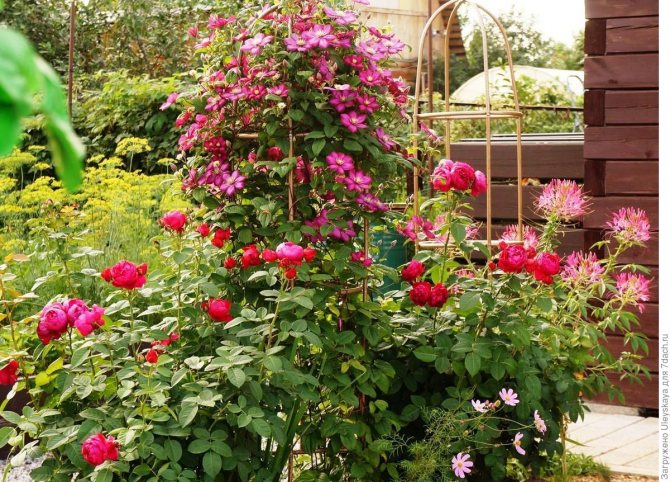

Cleoma on the side in the flower garden.
It will be great in small groups between young, not yet grown ornamental shrubs, in high borders. Some consider the lower part of the plant not very attractive, so they often cover it with medium-sized flower crops.
Cleoma partners
She is gorgeous in nuanced combinations with such annuals as:
- three-month lavater;
- fragrant tobacco;
- aster (callistephus);
- hybrid verbena;
- godetia large-flowered;
- gomphrene spherical;
- ipomopsis red;
- clarkia marigold;
- cultural dahlia ‘Funny guys’;
- zinnia and others.


Cleoma with zinnia
Cleoma looks very good with the queen of flowers - a rose. It is also effective against the background of the king of lianas - clematis.
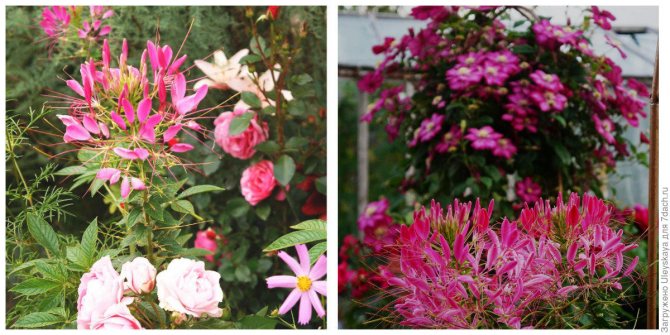

Cleoma with a rose and on the background of clematis. Other perennials will also go well with it:
- aster new belgian (dwarf varieties);
- toadflax;
- penstemon;
- small petals;
- chives;
- phlox paniculata and so on.
Cleoma looks better not as a tapeworm, but in a group planting. This original plant immediately attracts the eye, even if it is placed in the background of a flower garden. A small group planting of cleoma among lower plants looks very beautiful. True lovers of an exotic beauty create magnificent one-year backstages out of her.
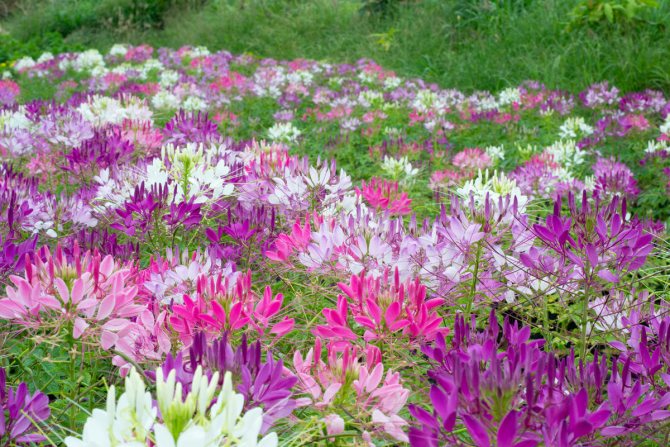

Cleoma flower garden
Cleoma is truly universal: when cut, it stands in water for up to 2 weeks (it is believed that its flowers, even in a bouquet, are capable of neutralizing harmful substances in the room).
More and more often, professional florists use openwork cleoma inflorescences in their works, because amazingly graceful flower arrangements are obtained with them.
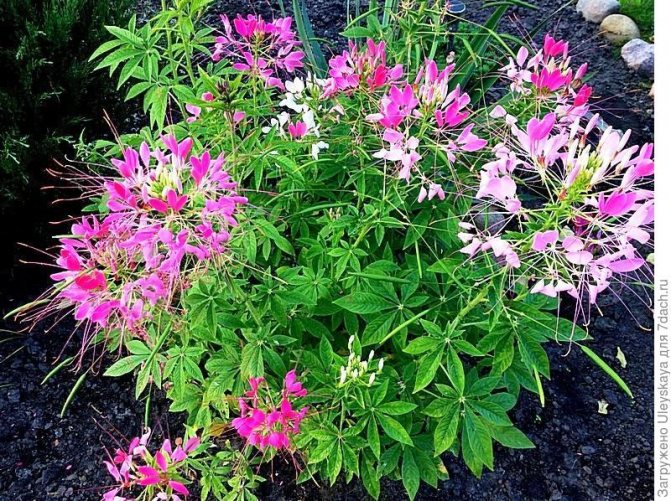

Cleoma 'Color Fountain'. So my short story about an amazing exotic beauty has come to an end. I hope I managed to reveal all the secrets of cleoma, and now you will certainly begin to grow it in your country house.
A source
Features of planting seeds for the winter
A plant from seeds is planted directly into the ground.As a rule, disembarkation takes place before winter or in spring. In order to get an early plant, you can plant seedlings.
How to grow glue from seeds in winter? Planting before winter does not require special seed preparation. Grooves up to two centimeters deep are made in the ground and sown evenly. It is not necessary to water the garden bed, as the seeds will lie in this form until the arrival of heat. After the spring sun warms up, moisture from the soil will get to the seeds, and they will begin to germinate.
Cleoma growing rules
Since Cleoma is a very unpretentious plant, taking care of it is not particularly difficult. But if you want to get a lush and long flowering, then you have to make some effort.


Watering
Watering Cleoma is necessary as needed, when the soil is dry. Reinforced watering is needed in a drought. The bright sun Cleoma tolerates much better than waterlogging. With prolonged rains, the plant loses its decorative appearance. After each watering, it is advisable to loosen the soil and carefully remove weeds.
Top dressing
For good flowering, 1 time in 2 weeks it is necessary to fertilize with complex fertilizers. If the bush develops slowly, you can spray it with Fertika Lux solution over the leaves. To obtain early flowering, it is necessary to spray the plant with a solution of "Zircon" at the beginning of the budding period.
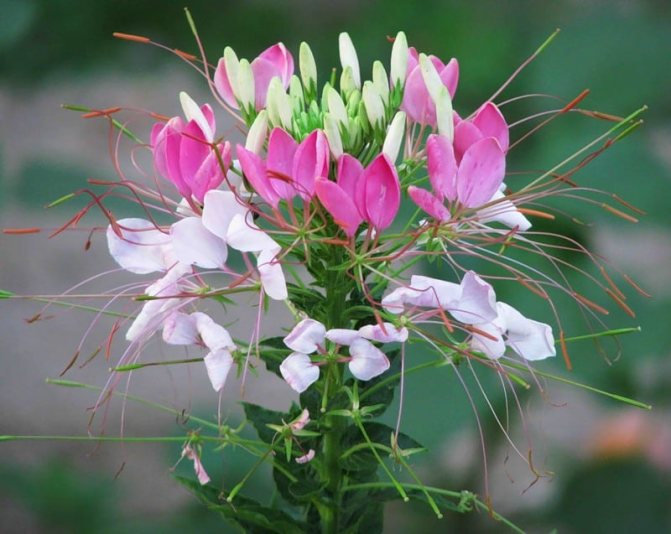

Winter period
Once Cleoma has faded, it must be disposed of. If you intend to get seeds, then you need to leave a few inflorescences to form seed pods.
Interestingly, when the pods with seeds ripen, they begin to burst, and the seeds fly out of them with a crash, scattering throughout the area. To prevent self-seeding, experienced flower growers recommend tying gauze bags to the pods, and then the ripe seeds themselves will fall into them from the burst pod.
The resulting seeds are sown into the soil in the usual way in November-December, without soaking them in a solution of a growth stimulant and without watering the soil. They simply bury the seeds 1.5 cm and cover them with spruce branches. Seeds that have overwintered in the soil begin to germinate with the onset of spring.
Planting seeds in the ground


If you decide to plant seeds in the spring, then the grooves made should be filled with water. It is recommended to plant a plant in spring in April or May, depending on climatic conditions. For rapid germination of the plant, it is recommended to treat the seeds with a growth stimulator. The seeds placed in the solution should stay in it for about fifteen hours.
When all the preparatory processes are completed, the seeds are placed in the soil to a depth of no more than three centimeters with a distance of about thirty cm between them. The seeds germinate rather slowly. Shoots germinate in the ground for about a month. You can speed up the growth process a little, cover the plant with plastic wrap. Above is a photo of cleoma flowers without film. After the first leaves appear on the seedlings, the plant must be transplanted. The distance between flowers should be at least sixty centimeters. The transplantation of flowers should not be delayed, young plants can easily tolerate a change in habitat.
Types and varieties of Cleoma
Currently, there are about 70 types of Cleoma. They differ in color of flowers and stem height. The most famous are Cleoma Prickly and Cleoma Hassler.
- The most common variety of Cleoma prickly called "The Cherry Queen". Flowers of this variety have an original shape and color of white, pink and lilac, they have a pleasant aroma. The stems of the plant reach a height of 60 cm, there are no thorns on them. The flowering period is from July to mid-September.
- The most popular variety of Cleoma Hassler is called Champagne Splash. The color of the flowers is white and pink, the stem height reaches 120 cm.The inflorescences are about 20 cm in diameter, they really look like a spray of champagne, this is clearly visible in the photo. A feature of this variety is a long flowering period - from July to the very October frosts.
Other popular varieties with flowers of various colors have also been bred:
- white flowers - Hellen Campbell;
- lilac flowers - Sparkler Lavender;
- inky purple flowers - Violet Queen;
- golden yellow flowers - Golden Sparkler.
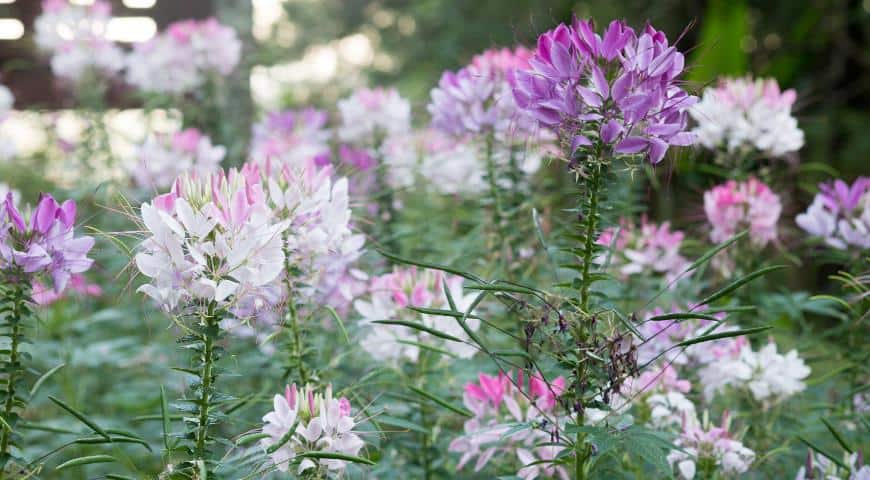

Cleoma. Seedling
Also, cleoma flowers are planted with seedlings. Thanks to this planting option, the flower begins to bloom earlier and delights the eye. To plant seedlings, you first need to prepare the soil. For good seedlings, you should take soil with the following content:
- turf;
- sand;
- humus. Seeds are planted in the prepared soil.
To accelerate growth and the appearance of the first shoots, seeds should be treated with humate or other nutritious growth stimulant. The seeds are soaked in the solution for about ten or fifteen hours, after which they can be planted in a special box with soil.
Given the fact that the planting is done for seedlings, the size of the box should have a sufficient amount of space. The soil in the container is well compacted and grooves are made for the seeds. The depth of the grooves should not be more than three centimeters. After sowing the seeds, the soil is sprayed with water and covered with foil or glass.
The box with future seedlings should be placed in a room where the air temperature is at least twenty degrees Celsius. Already after a few weeks after sowing, the first shoots appear. It is worth noting that the plant needs abundant lighting. If the weather is rainy or cloudy, then it is advisable to turn on special lamps. Two weeks after germination, the plant can be dived and periodically fertilized.
Flowers are planted in the ground with seedlings along with pots. The distance between seedlings in the ground should be about 70 centimeters. The transplanted plant should be treated with fertilizer or growth stimulant, due to which the adaptation period will be insignificant and short.
Selection of partners for cleoma
Cleoma prickly will attract attention in any company. The best partners, shading the beauty of the plant, are rightly considered low-growing, flowering annuals or spicy herbs, for example, oregano, sage and hyssop.
Excellent partners for cleoma will be annual verbena, kosmeya, scented tobacco, annual phlox, brilliant sage, lavater, zinnias, delphiniums, nasturtiums, heliotropes, calendula. Of perennials, cleoma looks good together with rudbeckia, yucca, echinacea, roses, ornamental grains, any plants with basket inflorescences, as well as with all ornamental deciduous crops without exception.
Unexpectedly, prickly cleoma combines well with large climbing vegetables - cucumbers, beans, zucchini, growing nearby allows you to achieve better pollination of both crops.
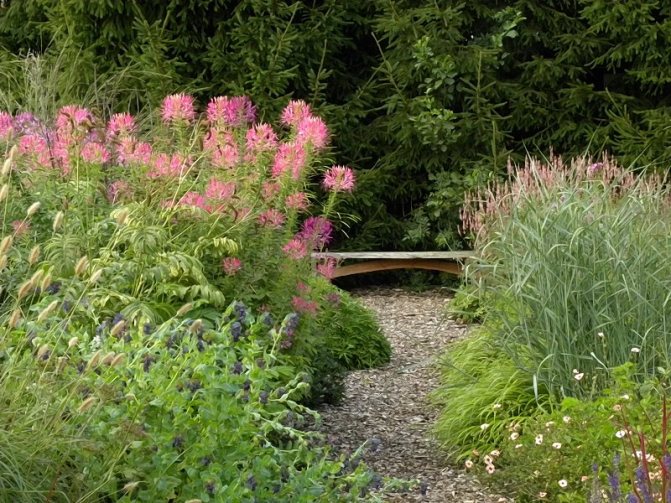

Cleoma in the garden goes well with spicy and ornamental grasses and cereals.
Cleoma care rules
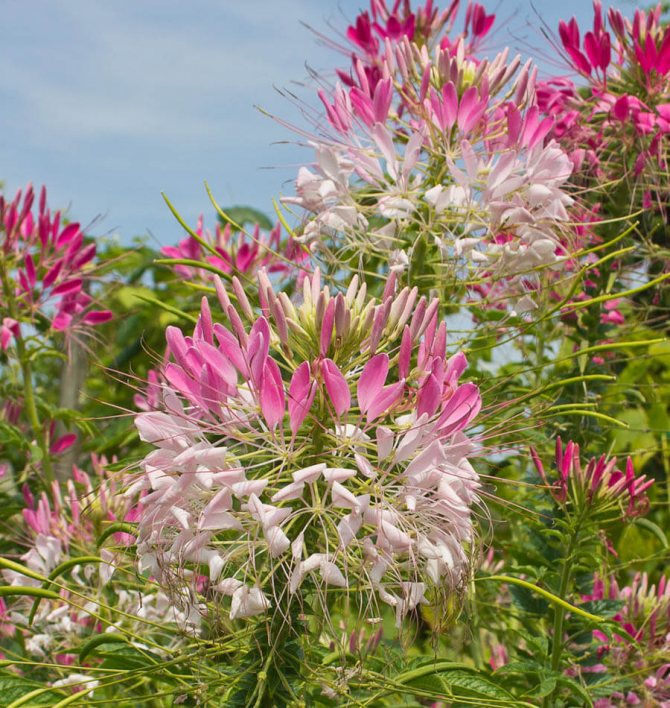

Despite the fact that the plant is unpretentious and non-capricious (above is a photo of a cleoma flower), the rules for growing everything must be observed:
- The plant should not be watered often and a lot. Because, although Africa and Latin America are considered the birthplace of cleoma, waterlogging can negatively affect the vitality of the flower. Strong moisture is needed exclusively in hot weather, in other cases it is not worth it.
- The plant should be fertilized at least twice a month. If the flower is weak, then its leaves can be treated with a nutrient solution.To prepare the solution, mix 3 liters of water and one tablespoon of fertilizer. Stir the solution and process it.
- To stimulate rapid growth and flowering, constant feeding should be carried out with appropriate preparations, which are presented in great abundance in stores today.
- Cleoma care also includes getting rid of weeds. Weeds should not be allowed to obstruct the growth of the flower. Weeding and loosening the soil will have a beneficial effect on plant growth.
- In the fall, the plants are harvested and the soil is prepared for the next season. Due to the ease of maintenance, such plants are often planted in summer cottages, flower beds near the house and in park areas.
Conditions required for cleome prickly
To select a comfortable place in the garden, it is enough to take into account the natural area of distribution of prickly cleoma. This tropical and African giant is a real sun worshiper, so in the gardens, especially in the middle lane, the brightest "southern" areas are chosen for the plant. Any shading for this summer is unacceptable. Cold winds and drafts should be avoided, paying attention to the most protected and warmest places.
In the choice of soils, the main attention should be paid to good drainage: the plant will not tolerate any dampness, stagnant water. Important for cleoma prickly and fertility, and light texture of the soil. This plant prefers to grow in sandy soils, fresh, well worked. The reaction of the soil for the cleoma of prickly must remain neutral.
Transplanting a flower
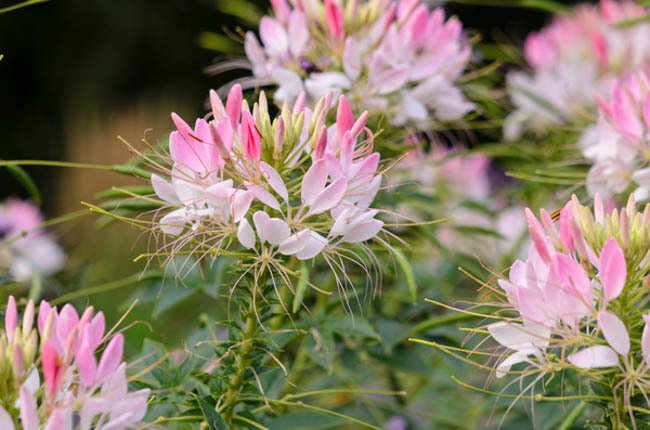

One of the prerequisites for care and growing rules is transplantation. If the reader looks above, he will see a photo of cleoma flowers, which are so mesmerizing. The bush grows quickly enough, because of this, it periodically has to be planted. Thanks to transplantation, the shrub becomes less susceptible to diseases. The flower can be transplanted after the first leaves appear on the stem. To transplant the soil, you need to fill it well with water and carefully pull out the root. Cleoma tolerates transplantation well, therefore, in a few days the flower will regain its strength and will continue to grow.
Growing from seeds
You can grow glue at home from seeds. To get a strong plant, it is necessary to carry out sowing for seedlings. Only seeds that were harvested last fall are used.
Sowing
Sowing is best in late February - early March. Before this, the seeds must be soaked for 10-12 hours in one of the solutions (Epin or Zircon). 200 ml of water will require 2 drops of the drug.
Soaking will significantly speed up the germination process. After that, you need to sow seeds into the soil of a shallow box. The soil should consist of humus, garden mixture, sand in a ratio of 2: 2: 1. To create a greenhouse effect, the container is covered with glass.


Seedling
Germination can be expected only 2-3 weeks after sowing. With the appearance of the first shoots, the box is transferred to a bright place. The best option is a windowsill. Additional lighting is provided in the evenings. Watering should be infrequent, but abundant.
To prevent infection with root diseases, a solution of potassium permanganate is used for prophylactic purposes. The event is held once.
At the stage of the appearance of leaves, they are dived into a container with grounding into the ground to cotyledon leaves. After 14 days, seedlings are fed with complex fertilizer. Then the procedure is repeated with an interval of 2 weeks. If the plant stretches to one side, then it must be turned periodically towards the light source.
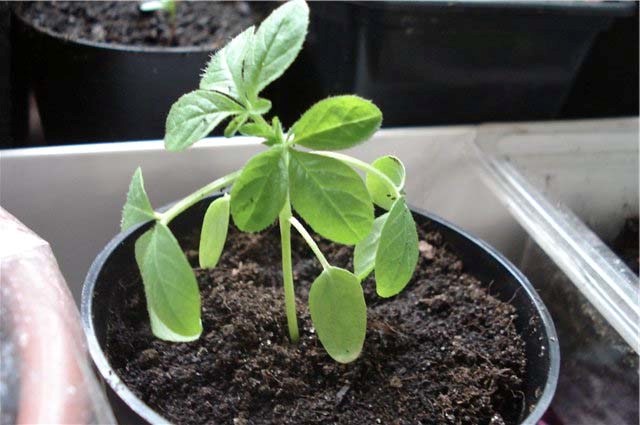

Open ground transplant
Taking into account the peculiarities of the structure of the root system, young plants tolerate transplanting well into open ground. It takes place in mid-May. The place should be bright and sunny, protected from drafts and winds.
The distance between the seedlings is approximately 50 cm.When planting, the soil is well loosened. A soil with moderate fertility and neutral acidity is selected, otherwise the cleoma will grow, and the flowering will be rather weak.
Transplant rules:
- the transplant is carried out only after all frosts;
- the specified distance between seedlings must be observed;
- prepare the soil in advance - add rotted compost along with complex fertilizer in a proportion of 2 tablespoons per 1 sq. m;
- for better rooting, they are sprayed with micronutrient fertilizers;
- after transplanting, humate is irrigated in the dosages specified in the instructions.
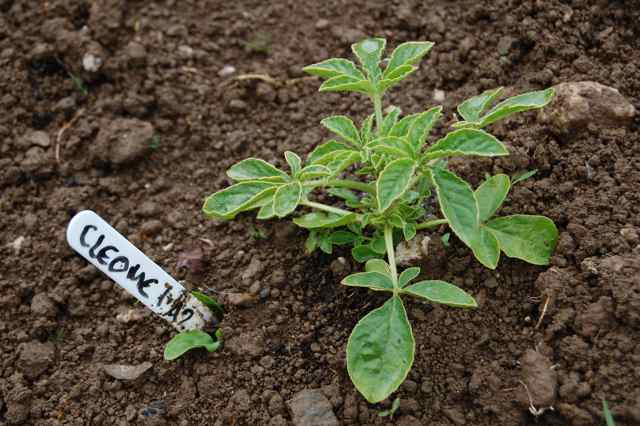

Protection against insects and pests
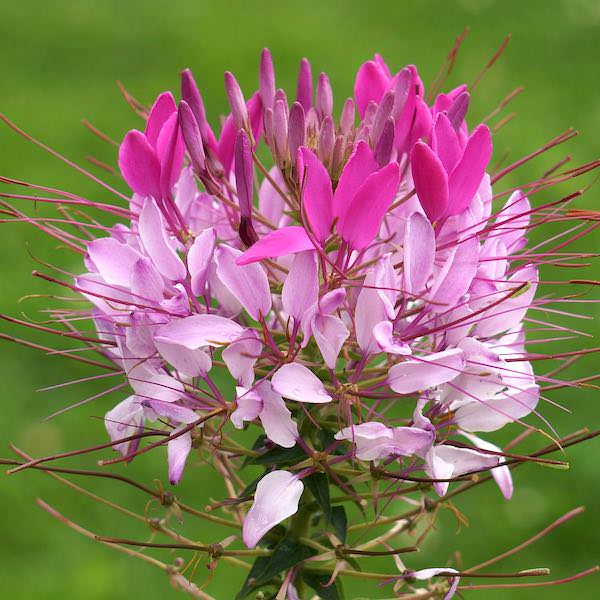

Unlike other types of flowers, if you look at the photo, the cleoma does not need special processing. Due to the specific smell, most insects and pests do not come close to the plant. Many gardeners use glue to protect their beds from insects and pests. Bushes are planted around the entire perimeter of the garden, thereby protecting the territory from small enemies. Insects such as mosquitoes, flies, aphids and other pests of cultivated plants are afraid of the strong aroma of the flower.
Despite its high protective characteristics, the plant is susceptible to some diseases: gray rot and powdery mildew. As a prevention of such diseases, you can try to regulate irrigation and watering. If the plant already has infected areas on the leaves, then "Fitolavin" and Bordeaux liquid will help get rid of the problem. The plant has good immunity to various kinds of diseases, however, improper watering can lead to a deterioration in the health of the plant and even death.
Description of the plant
Cleoma has strong roots, long sturdy stems with short, stiff pines. Plant height reaches 1.5 m. Leaves are bright green, alternate, slightly pubescent on the back with minor thorns. The leaves of Cleoma resemble chestnut leaves in shape, but are more pointed at the ends.
The flowers are located in a racemose inflorescence, the diameter of which is about 20 cm. The flowers themselves are of the correct shape, of various colors - white, pink, lilac, purple and even yellow. The stamens of the flowers are long, similar in appearance to the legs of spiders. Cleoma blooms from June to late September.
Cleoma fruits are pods up to 5 cm long, which are single-nested polysperms. Outwardly, they look like thin pods on long legs, and absolutely do not spoil the decorative appearance of the plant. Seeds are round, dark gray, 1-1.5 mm in diameter.
The smell of Cleoma flowers is not very pleasant, but it is not felt in the open space of the garden. Its purpose is to lure bats that pollinate this plant, and it perfectly repels a variety of harmful insects.
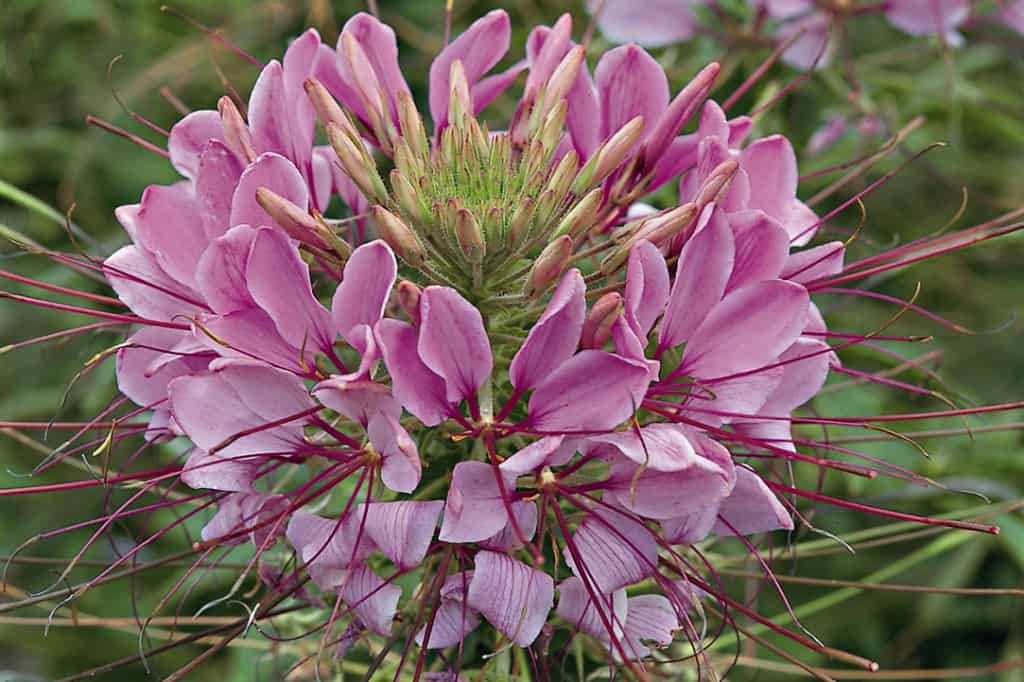

Seed collection


In order to plant new flowers next season, you need to collect seeds. The cleoma flower attracts many pollinating insects. In the place of flowering, a fruit appears, which in appearance resembles a pea or bean pod. There are seeds inside the pod. They must be collected immediately after ripening, when they turn yellowish or brown, and their diameter is 2 millimeters. The photo shows cleoma and if you look at the first 4 pictures from the right side, then its seeds are photographed on them.
The easiest way to collect seeds is to use a cloth or gauze. A fabric cover is put on the pod, into which the seeds fall out after ripening. You can also wear a sock as an alternative. When the seeds are harvested, the stem of the flower can be harvested and the soil can be prepared for the next planting.
Cleoma does not require special care or other requirements; such a plant can be grown by any novice and experienced gardener. With proper planting and seed collection, you can have an attractive flower bed every year.
What Cleoma Loves
For an exotic beauty, it is advisable to find a sunny planting site with fertile, well-drained neutral soil.
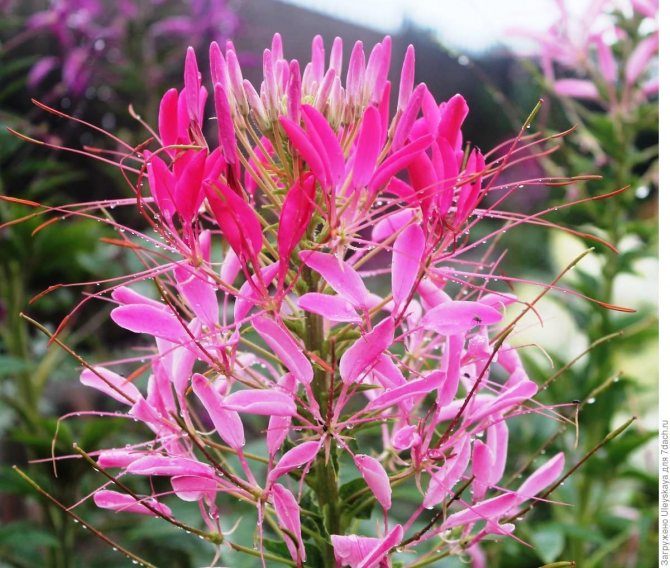

When done right.
And cleoma also loves space - compacted plantings are not for her, take this into account when planning flower beds (it is advisable to adhere to a distance between plants within 40-50 cm).
Practical adviceIt would be good to prepare a place for planting cleoma in the fall: add 1 bucket of compost and 2 tbsp for digging. tablespoons of complex granular fertilizer per 1 m² of area.
Specific uses of the plant
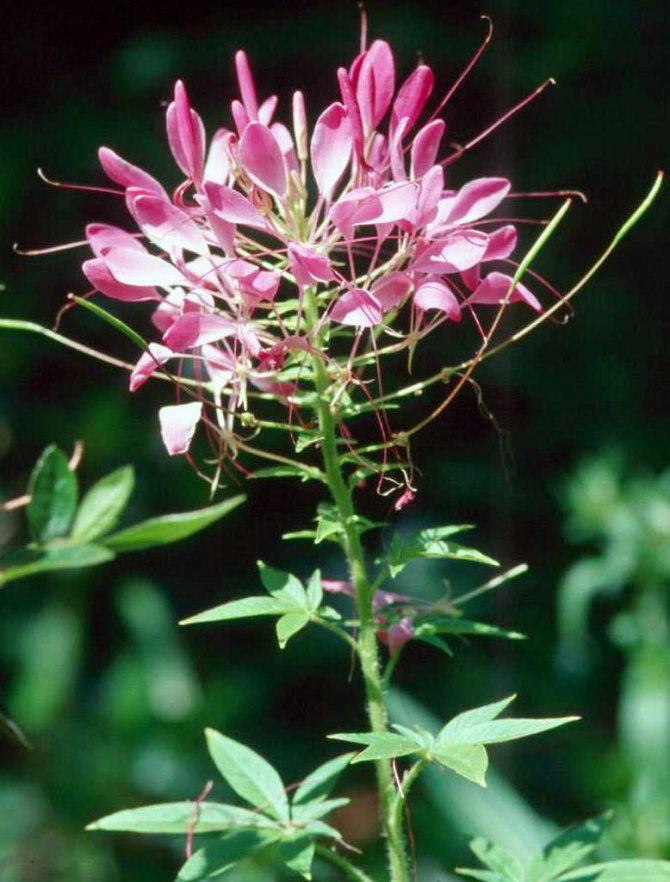

By using cleoma flowers, you can also protect your garden from pests and insects. In order not to use various chemicals and other poisons, it is much easier to plant a plant and harvest an environmentally friendly crop in the fall. If you look closely at the cleome, the photo of flowers is very bright and rich.
Due to its growth, which reaches one and a half meters, the plant can also be used as a living fence. A flowering fence will look beautiful, and as an addition, protect your site from flying and crawling insects. Such a hedge will put a certain emphasis on the landscape decor, which will ideally fit into the existing design.
Of course, keeping such a fragrant flower in the house is unlikely to work, but when it grows in the yard or in a flower bed, the spicy smell will fill the air masses and carry it over a large area. A beautiful flower can be a real addition to a yard flower bed or an individual flower grower.
The use of prickly cleoma in the design of the garden
The status of a beautifully blooming exotic plant and one of the most original flowering plants for any garden with prickly cleoma cannot be disputed. This is a unique annual, capable of standing out against the background of any plants and yet the first to attract the eye even in the most variegated composition.
There is only one rule in using this plant: it is better not to use glue in flower beds, and in the garden as a whole, as single plants. This spectacular beauty best of all reveals its beauty in groups of at least three plants.
Kleoma prickly is planted:
- in classic flower beds;
- in mixborders;
- as decoration for groups of shrubs;
- in discounts;
- to create temporary hedges;
- in the front garden;
- in rockeries and rock gardens;
- in flower beds made of exotic plants;
- in flower beds from summer houses;
- for decorating a decorative garden.
Cleoma prickly is a valuable cutting plant. Its inflorescences in arrangements last up to 10 days, which does not prevent cleome from remaining an exotic favorite of florists.
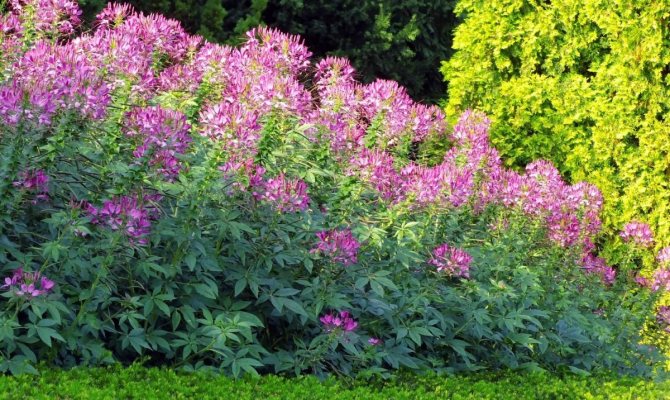

Cleoma in the garden is used, in particular, to create temporary hedges. <>
Care ↑
The spider is unpretentious in care and even a novice gardener can grow it.


The plant's water needs are average, but she does not like long waterlogging. It needs to be watered infrequently, but abundantly.
Complex fertilizer can be applied 1-2 times per season. But if the soil is good and fertile, then fertilization is not worth it, otherwise it will become too stretched and, due to its flexibility, may lie on the ground.
Indoor flower cleoma
Usually this unusually beautiful annual is planted in garden plots. But if you adhere to certain rules for caring for this plant, then the indoor flower "champagne spray" may well become an interior decoration. Compliance with simple agricultural techniques allows you to admire its amazing flowers for several years.
To do this, it is necessary to bring the conditions of its maintenance closer to natural ones. Considering that the homeland of cleoma is the tropics, it should be placed on the sunniest windowsills, and the air temperature in the apartment in the summer should not fall below 20⁰С. In winter, coolness is required - about 15⁰С. Regular spraying will create the moisture necessary for a tropical plant.
The rest of the flowers "champagne spray" are rather unpretentious and hardy.Planting and caring for them does not cause any particular difficulties, even for novice florists. It is enough to provide regular watering and feeding with ordinary fertilizer for indoor flowering plants.
What to do if the seeds did not sprout
Slow pecking and germination of seeds is normal for cleoma. If the percentage of germinated seeds is small, you can try to stimulate them additionally. But if the seeds were pretreated with Epin, this method is unlikely to help again.
An alternative way to increase the germination of seeds is to expose them to contrasting temperatures: during the day, a box with seedlings is placed on a warm windowsill under the rays of the Sun, and put in the refrigerator at night.
A few days of such procedures are able to "spur" more than 2/3 of un germinated seeds to hatch.
Features and characteristics of the plant
Cleoma prickly refers to an annual shrub plant of the caper family native to South America. The stems grow up to 0.5-1 m, on top are decorated with inflorescences with four petals and long stamens, which create volume and resemble spiders a little. The diameter of the brush can reach 20 cm, and throughout the season, new flowers form at the tips of the inflorescence, which lengthen it. The leaves are green, collected in a small fan, consisting of seven leaves.
Cleoma blooms from early summer to September - first the lower inflorescences bloom, and then the upper ones. By the end of the flowering period, the stems of the plant become stiff and fruits appear on them - small pods filled with yellow or black seeds. One of the advantages of cleoma is that it has many varieties and shades, and some varieties combine two colors at once and look especially original.


Cleoma has an original, unusual appearance
In landscape design, glue can be used for any purpose. It is planted in the background of compositions, combined with other original plants (for example, with dicenter) or flowers of light and cold shades - white roses, verbena, sage, echinacea. With the help of plant bushes, you can mask unsightly places on the site or create a natural screen. Cleoma is also well suited for cutting - one of its lush, airy inflorescences can replace a whole bouquet.
Outdoor care
The South American plant is quite unpretentious, but does not like boggy. It is useful to pay at least a minimum of attention to a beautifully blooming species - and on the site for the whole summer and at the beginning of autumn, bright colors of inflorescences, similar to large balls-brushes, will blaze.
Watering
Cleoma is a drought-resistant plant, the shrub tolerates moisture deficit more easily than stagnant liquid in the soil. It is important to find the optimal irrigation regime, taking into account local conditions: often flower growers are faced with the development of root rot when the substrate is waterlogged.
Another negative factor is the placement of Cleoma prickly in the wrong place: in the lowlands, part of the water accumulates after rain, and the soil does not dry out for a long time, which negatively affects the plant.
Top dressing and fertilization
At the first stage, to activate the growing season, more nitrogen is introduced. When forming flowers, potassium and phosphorus will be needed, the proportion of nitrogen is reduced. Mineral mixtures are suitable for beautifully flowering plants.
Note! It is important to apply fertilizers taking into account the consumption rate and strength of the product, optimally every 14 days. Many experienced flower growers advise adding foliar dressing with the same composition. Weakened bushes are treated with a solution based on the Zircon preparation.
Choosing a variety for planting
Only two types of cleoma, out of more than 70 existing ones, are used as ornamental plants - Hessler's cleoma and prickly cleoma.When breeding new varieties of plants, these two species are crossed with each other.
Popular varieties derived from prickly cleoma:
- Helen Campbell. Plant with white flowers.
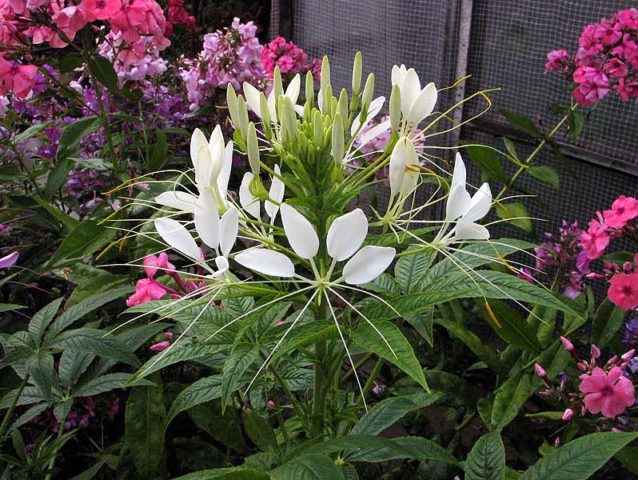

- Pinkquin, Rosequin, Rosakeningen - a group of varieties with a pinkish tinge of inflorescences.
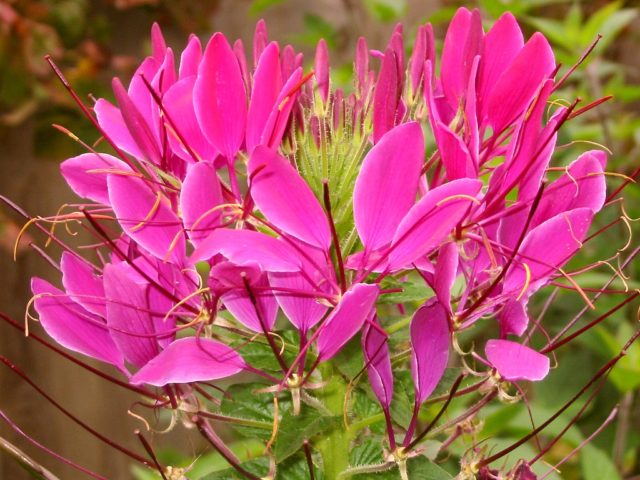

- Gold Spakrler is a variety no higher than 40 cm with yellow petals.
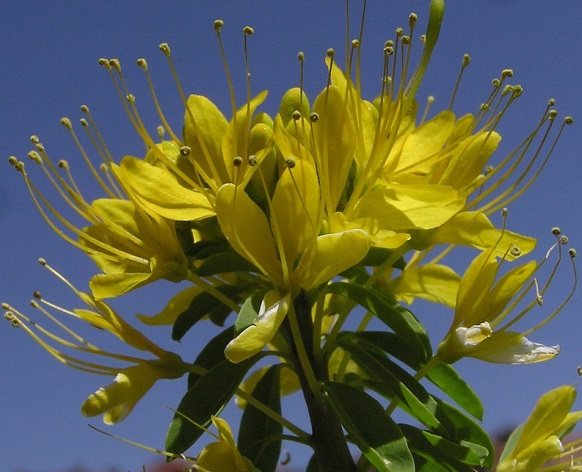

- Guyant Pink Cusin - bushes 60-80 cm high, dark pink in color.
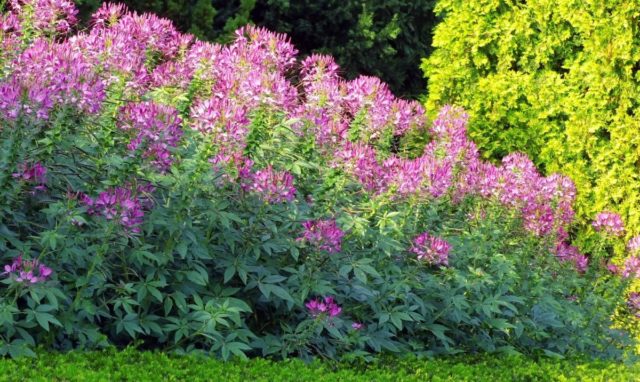

- Lavender Sparkler - light purple inflorescences.
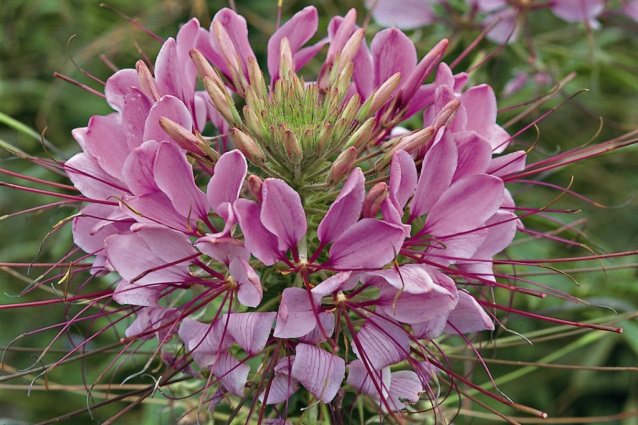

- Vayletkvin - dark purple inflorescences.


Also, the variety Cherry Queen is very popular among gardeners among plants derived from prickly cleoma. It has an average bush height (no more than 60 cm) and elongated flowers. Although they are collected in inflorescences, they are so far from each other that they give the impression of individual flowers.
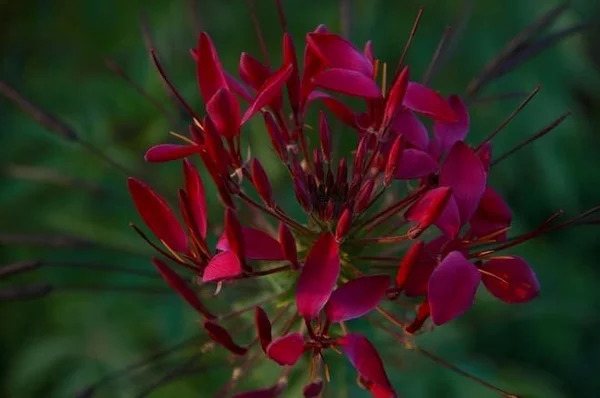

The rules for growing different varieties of cleoma are the same, since the timing of various stages of plant life, vegetation, flowering and fruiting, is completely identical.
Possible difficulties
Cleoma is resistant to diseases and pests. Only in a dark and damp place can bushes be affected by fungal diseases. Parasites not only do not attack the bushes, but are also afraid of their pungent smell. Therefore, there is no need to worry about the safety of beautiful plants. The insect repellent property can be used. It is enough to plant the glue next to other flowers or beds, and it will protect the neighbors in the garden from parasites.
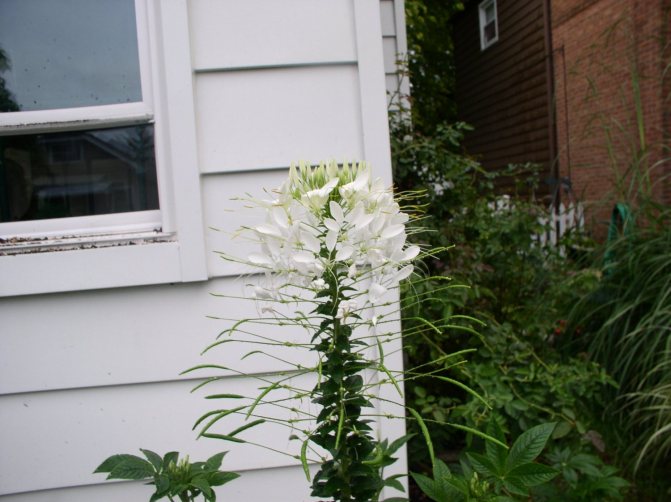

Botanical description of cleoma and a photo of this plant
Perhaps we should start with a botanical description of this garden plant. Cleoma is found in various forms in almost all corners of the world, but mainly its abode is in warm and temperate regions. In general, this plant can grow as a shrub or grass. The shortly glandular-drooping stems have a fairly large branching, on which the leaves are arranged in a regular order. The leaves themselves can have both fairly simple and complex structures, as in the photo below.
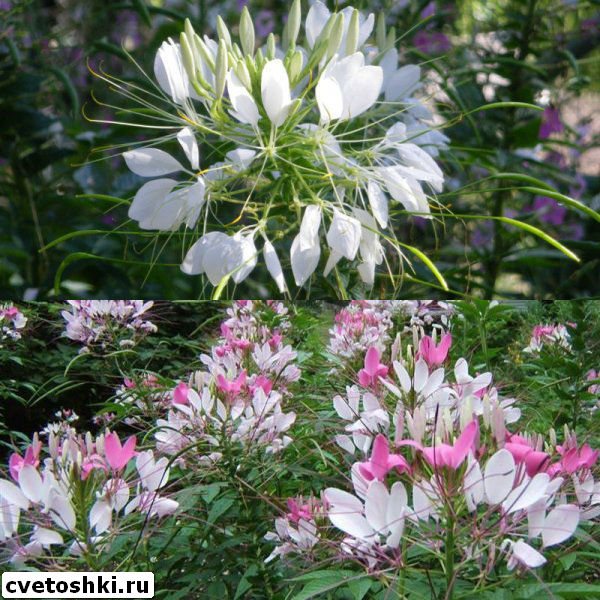

As for the flowers, they are located at the very top with brushes and can have a bright color. For example, inflorescences are often seen in pink, yellow, white, or pale purple. According to the Germans, the colors of the cleoma are very similar to the spray of champagne, but not many people like such a plant, since it has a rather specific smell. But, despite this, it does not look bad and decorates courtyards and gardens. After the cleoma fades, you can observe the fruits, which are a pod-shaped capsule, no more than 3 cm long.
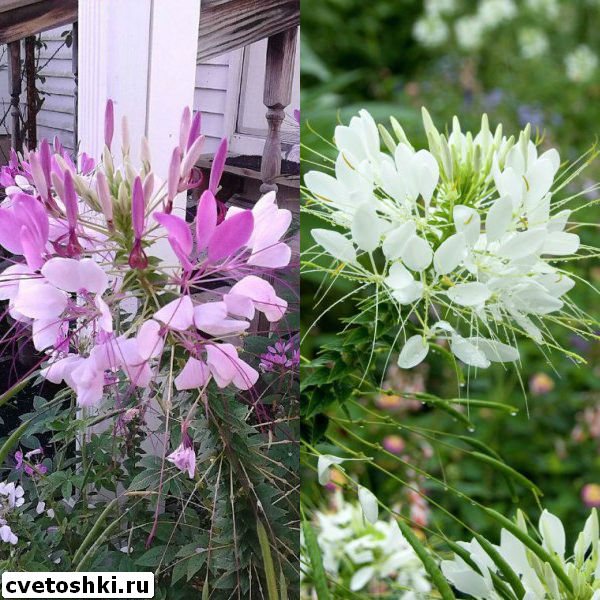

The Germans often call such a flower "spider", all due to the fact that its inflorescence has a rather unusual shape - on one side there are long stamens and a pistil, and on the other, four petals. The plant blooms with buds, the diameter of which can reach 20 cm, as in the photo below. At the same time, cleoma can become a real decoration of any garden, many even grow it in a group with scented tobacco and lavater, in such an ensemble the cleoma will be a salt plant.


Cleoma in landscape design


Cleoma in landscape design photo of flowers
The tall cleoma plant is used as a hedge. Bright flowers are beautiful in solo plantings. In groups, combine different shades to create interesting flower arrangements. Good neighbors of cleoma will be fragrant tobacco, lavater, lilies, marigolds.
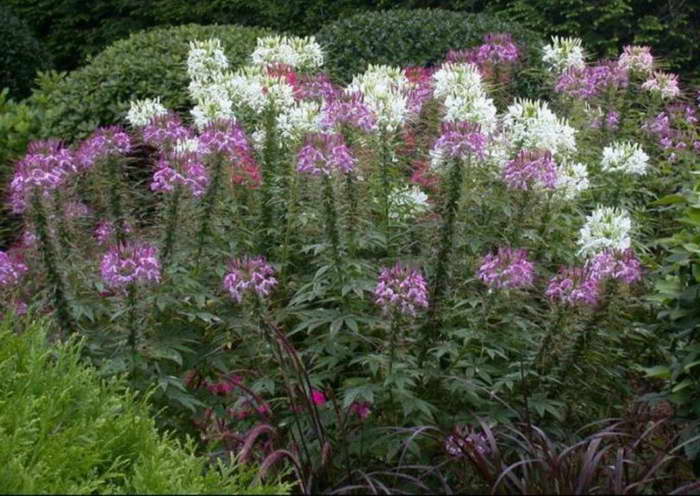

Cleoma on a flower bed mix of flowers photo
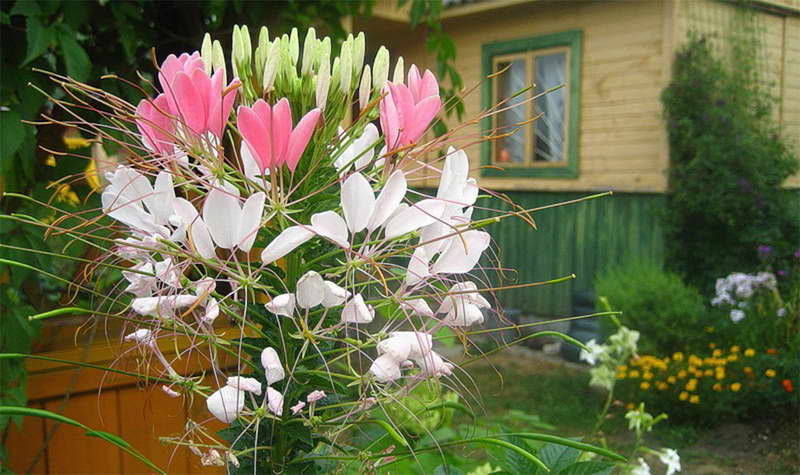

Cleoma splashing champagne photo
Site selection and soil composition
It is worth planting seedlings or sowing cleoma seeds on sunny, non-shaded areas of the earth. When planting, it is necessary to avoid proximity to shrubs and trees, since the root system of a tree can interfere with the development of a powerful root system of cleoma.
The soil for planting should be nutritious, without stagnation of water. It is best to plant the plant on a hill or area where rainwater does not drain.
Prepare the soil for planting in early May.The soil must be dug up and fertilized with compost. You can add mineral fertilizers to the soil. You need to plant flowers according to the scheme 50X40 cm.
Post-flowering care
Cleoma in horticultural culture is grown as an annual. Autumn activities after flowering are to remove dry stems. Only peduncles are left, selected for the ripening of seeds necessary for sowing.
After sowing, this beautiful representative of the flora blooms for a long time. The first buds appear already in June, it is during this period that experienced gardeners already note the inflorescences from which they will collect seeds.
Seed collection
- In the middle of autumn, flowering ends and bolls appear. They are placed in bags made of gauze. This will allow you to collect all the seeds after the ripe fruits have burst.
- The mature seed is round and brownish or yellow in color. For spring sowing, they are additionally dried at room conditions and stored in a dark room in a paper envelope.
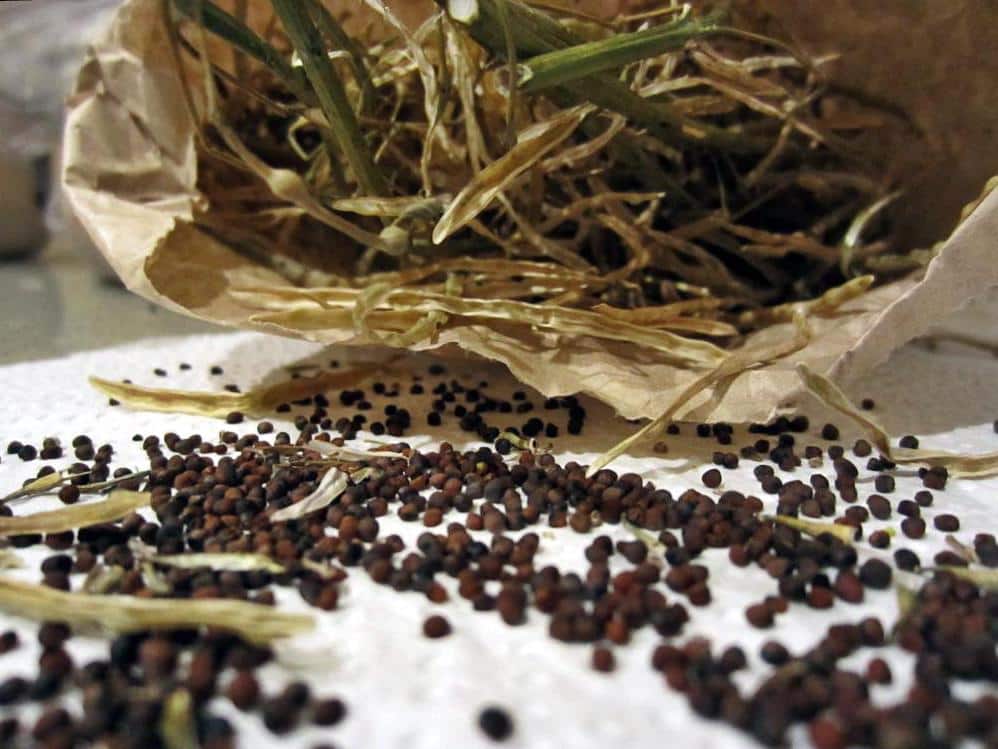

Cleoma seed preparation
Description of Hassler's cleoma ↑
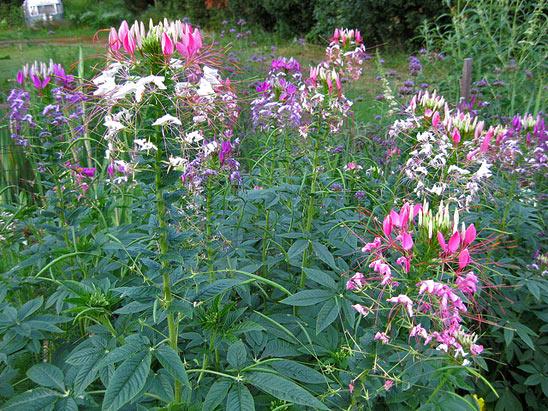

Name: Cleome hassleriana Category: in zones of Russia it is grown as an annual plant, but in zones 10-11 it is grown as a perennial. Type: erect stem, on top of which is a spherical inflorescence. The spider grows well, although it has shallow, but powerful roots.
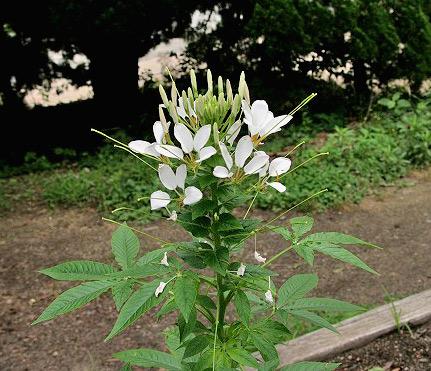

Leaves: light green. Above they are smaller, in the lower part - large, shaped like a chestnut. At the bases of the leaves, thorns are hidden, because of which the glue was nicknamed prickly. Plant height: 60-90 cm Inflorescence color: pink, white and its shades, purple and lavender. Flowering time: long and abundant. Begins to bloom in June-July, inflorescences appear and bloom throughout the summer, until autumn.
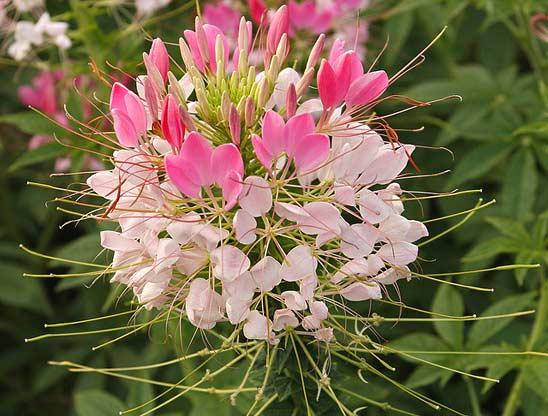

Another feature of the plant is its specific aroma, which not everyone finds pleasant, but attracts many bees. This smell comes from the little sticky hairs that cover the entire plant.
Growing seedlings
For growing seedlings, seed is sown in March, at about tenths. The seed containers should be about 15 cm deep and the substrate should be composed of compost, fertile garden soil and sand (2 to 2 to 1 ratio).
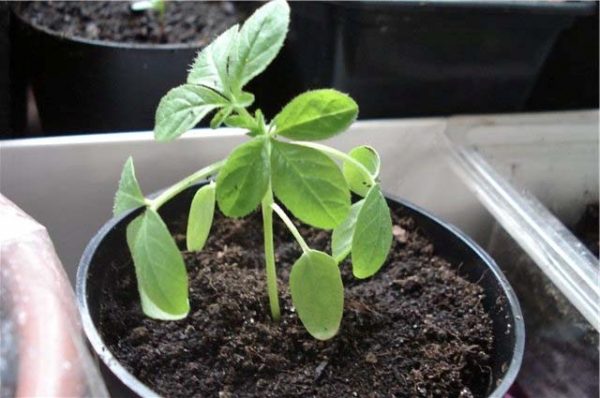

Seedling growing method produces strong seedlings
table 2. Step-by-step instructions for growing seedlings from seeds of cleoma seeds.
| Step, no. | Description |
| Step 1 | Fill containers for growing seedlings with soil, sprinkle wood ash on top with a thin even layer |
| Step 2 | Plant the presoaked seeds to a depth of 1-1.5 cm, lightly sprinkle with soil. It is recommended to put a small layer of compost on top, which will serve as additional fertilizer for the seeds and contribute to rapid growth. |
| Step 3 | Lightly spray the soil surface with a spray bottle, cover with glass or foil and place in a place with a temperature of 20-22 ° C |
The first shoots will be noticeable in about two to three weeks, and during this time the seeds need to be provided with good care:
- water abundantly, but rarely, as the earth dries up - it is impossible to allow stagnation of the liquid, otherwise the development of fungal diseases is possible;
- containers should stand in a room with good lighting, and in the evening they should be supplemented with special agrolamps for several hours;
- once the seedlings need to be watered with a weak solution of potassium permanganate to prevent root damage by pathogenic microorganisms.
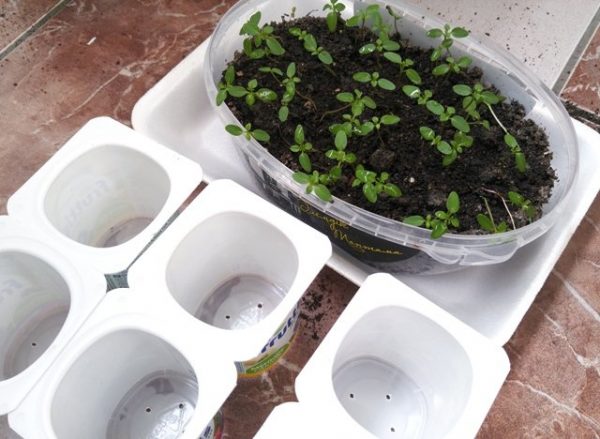

Cleoma does not tolerate a dive well, so all actions must be neat
After the seedlings grow, and a couple of leaves appear on them, they need to be dived into separate cups, preferably peat ones, filling them with a mixture of humus and peat. Seedlings must be transplanted carefully, together with an earthen clod, burying them into the soil to the lower leaves.
After 10-12 days, feed the seedlings with mineral preparations, and then feed them every two weeks.To prevent the bushes from turning out to be crooked, they need to be regularly turned in different directions towards the sun.
Advice! Cleomas do not tolerate transplanting well, therefore, for novice gardeners who do not have experience in picking delicate plants, it is better to plant seeds immediately in special peat tablets.
Content:
- Description of Hassler's cleoma
- Landing
- Care
- Where to plant the champagne splash glue
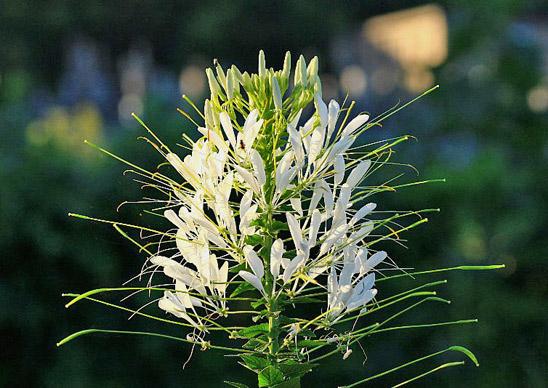

This flower has other names, which are also quite suitable: spider flower, spider, spider legs. If you look closely, the antennae of the flower are slightly curved at the ends, like those of the legs of spiders. This is especially evident in species with rare stamens.
Harvesting of seeds
Cleoma propagates exclusively by seeds. They are able to remain viable for up to 3 years.


Seeds are harvested in the fall, when the pod is ripe and opens easily when pressed. You can determine the degree of maturity by its color - it becomes darker. You can not overexpose the testes on the plant, since the pods, when ripe, burst, and all their contents are on the ground. To prevent this, you can pre-place some of them in gauze bags. Then, when the pod is opened, the seeds will not fall on the ground, but remain in the bag.


